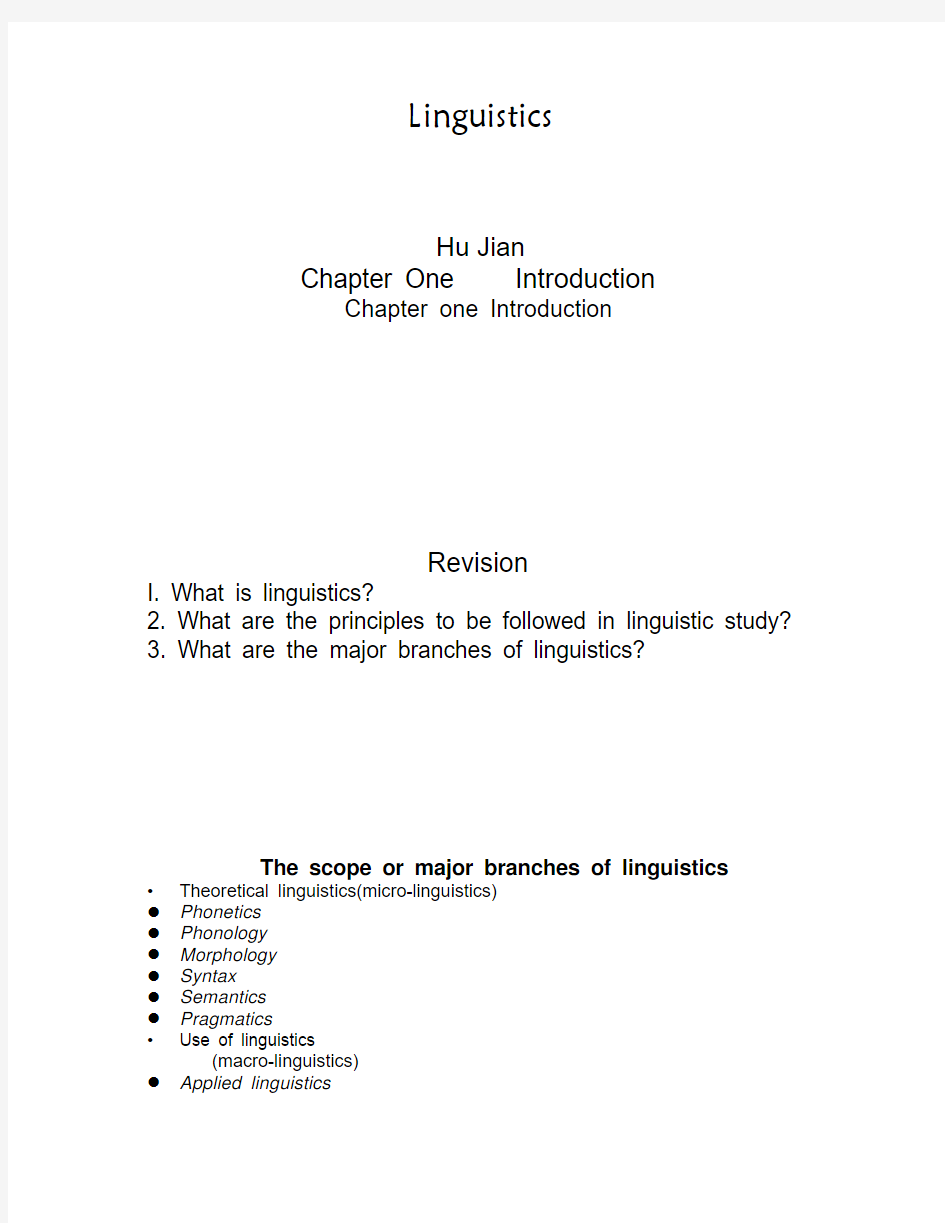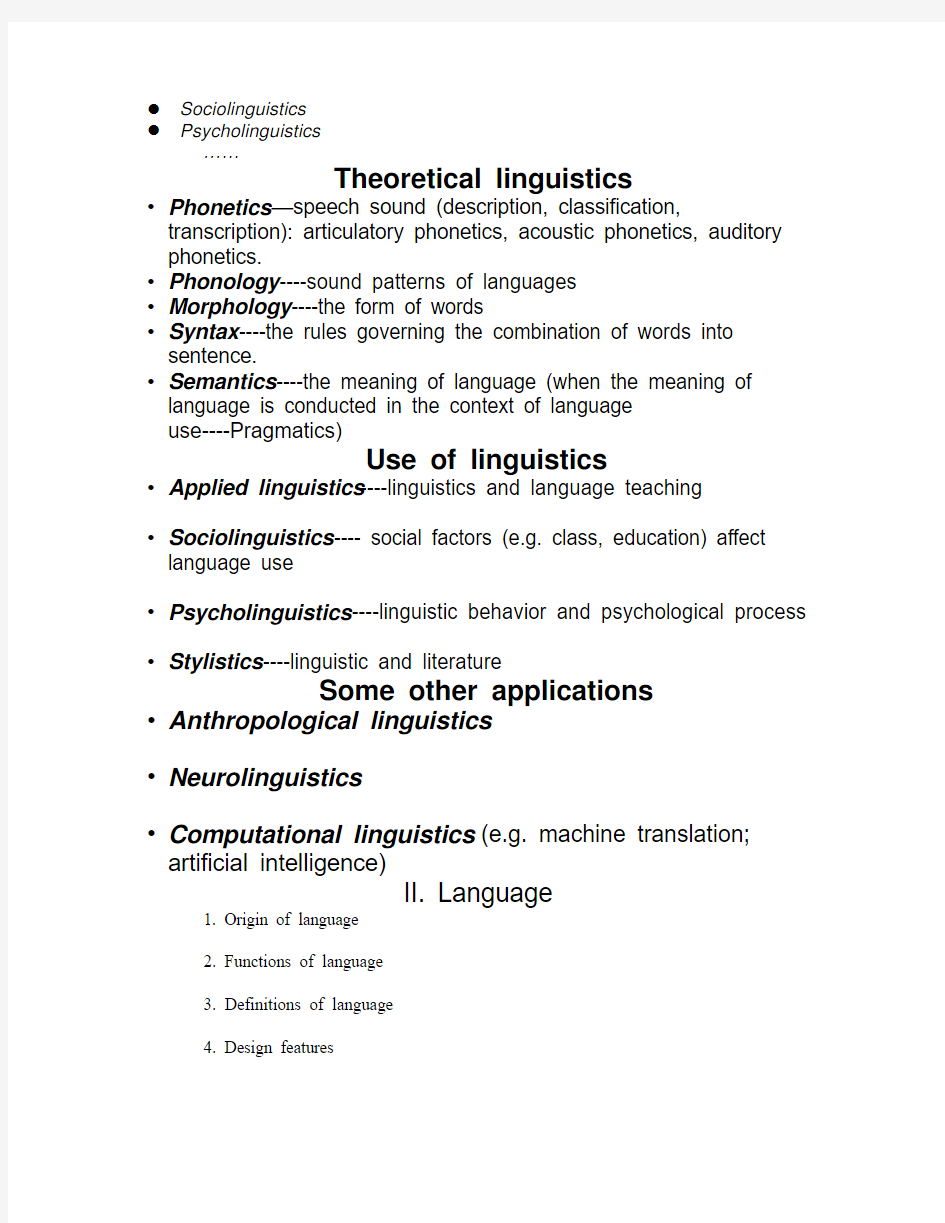

L i n g u i s t i c s
H u J i a n
Chapter One Introduction
Chapter one Introduction
Revision
I. What is linguistics?
2. What are the principles to be followed in linguistic study?
3. What are the major branches of linguistics?
The scope or major branches of linguistics ?Theoretical linguistics(micro-linguistics)
●Phonetics
●Phonology
●Morphology
●Syntax
●Semantics
●Pragmatics
?Use of linguistics
(macro-linguistics)
●Applied linguistics
●Sociolinguistics
●Psycholinguistics
……
Theoretical linguistics ?Phonetics—speech sound (description, classification, transcription): articulatory phonetics, acoustic phonetics, auditory phonetics.
?Phonology----sound patterns of languages
?Morphology----the form of words
?Syntax----the rules governing the combination of words into sentence.
?Semantics----the meaning of language (when the meaning of language is conducted in the context of language
use----Pragmatics)
Use of linguistics
?Applied linguistics----linguistics and language teaching ?Sociolinguistics---- social factors (e.g. class, education) affect language use
?Psycholinguistics----linguistic behavior and psychological process ?Stylistics----linguistic and literature
Some other applications ?Anthropological linguistics
?Neurolinguistics
?Computational linguistics (e.g. machine translation; artificial intelligence)
II. Language
1. Origin of language
2. Functions of language
3. Definitions of language
4. Design features
1. Origin of language
1.1 divine-origin theory
1.2 invention theory
1.3 evolutionary theory
Origin of language: a mystery and some hypotheses 1.1 Divine-origin theory: language is a gift form God to mankind.
According to a Christian belief, God gave Adam the power to name all things.
1.2 Invention theory: man invented language ?imitative: the earliest form of language was imitative ?Cries of nature: the earliest form of language consisted of ejaculations of pain, anger, fear, surprise, etc.
?Grunts of men working together
1.3 Evolution theory
? In the evolutionary development of the human species, language developed.
2. Functions of Language
?Phatic: to establish an atmosphere or maintain social contact rather than for exchanging information or ideas.
e.g. A nice day, isn’t it?
2) Directive: to get the hearer do something
e.g. Shut the door.
3) Informative: to tell what the speaker believes, to give
information about facts, or to reason things out (either true or false).
e.g. Water boils at 100 degrees Centigrade.
Functions of Language
4) Interrogative: to get information from others
e.g. When did he arrive?
5) Expressive: to reveal something about the feelings and
attitudes of the speaker.
e.g. Good heavens!
6) Evocative: to crate certain feelings in the hearer; to amuse,
startle, anger, soothe, worry or please.
7) Performative: to perform actions.
e.g. I sentence you to 10 years of hard labor.
Definition of Language: Language
is a system of arbitrary vocal
symbols used for human
communication.
Motivation
Motivation accounts for the connection between the linguistic symbol and its meaning.
Even onomatopoeic words do not arise simply from what they sound like. Only when you know the meaning can you infer the form is appropriate.
Do you agree?
Ode to a Nightingale
?The murmurous haunt of flies on summer eves.
For if this word expresses a natural connection, with the sound alone evoking what it denotes, whey does the similar-sounding word murderous not do so as well?
e.g. murderous
Arbitrariness
?The forms of linguistic signs bear no natural resemblance to their meaning.
Link: a matter of convention, differing radically across languages.
书、book, Buch
Note:
Words are arbitrary in form, but they are not random in use. It is precisely because linguistic forms do not resemble what they signify that they can be used to encode what is significant by convention in different communities.
e.g. Words denoting camels in Arabic
Words denoting snow for Eskimos.
Please read the following examples:
--Where is Washington ?
--He's dead.
--I mean, the capital of the United States.
--They loaded it all to Europe.
--Now do you promise to support the constitution?
--Me? How can I? I've got a wife and five children to support.
More examples:
?When a woman complained to her butcher that his sausage tasted like meat at one end, and but bread at the other, he replied, "Madam , in the times like these, no butcher can
make both ends meat ."
?What kind of rhetorical device is used here?
Pun
It is a play on words, or rather a play on the form and meaning of words.
The humorous use of word, or of words which are formed or sounded alike but have different meanings, in such a way as to play on two or more of the possible applications. Please look at this line from Keats again:
The murmurous haunt of flies on summer eves.
There is a repetition of sounds which are associated with the letter “s”.
But these sounds do not themselves have meaning. What they do is to combine in all manner of ways to form words which are meaningful.
?/s/ /f/ /ei/
?Safe /seif/
?Face /feis/
?Obviously this duality provides language with enormous productive power: a relatively small number of elements at one level can enter into thousands of different combinations to form units of meaning at the other level. ?So far we have considered duality in reference to spoken language. Does the same principle apply to written language?
?If yes, how?
?Letters enter into various combinations to form words whose different spelling signifies differences in meaning. Sometimes there is a coincidence between sound elements and letter elements. For example, safe and save.
Question:
就创造性而言,艺术和语言的差别何在?
Discussion:
?Explain lies. Why human beings can lie?
?LAD (language acquisition device)
?PPH (principles-and-parameters hypothesis) (State-0 L)
III. Key concepts
?descriptive vs. prescriptive
?synchronic vs. diachronic
?speech and writing
?langue and parole
?competence and performance
?modern linguistics vs. traditional grammar
6. Modern Linguistics
vs.
Traditional Grammar
Exercises
?Define the following terms, giving examples for illustration (if necessary):
?Linguistics
?Language
?Parole
?Arbitrariness
?displacement
Exercises
II. Indicate the following statements true or false: ?Language is human-specific.
?Language is a complicated entity with multiple layers and facets, and it is possible for linguists to deal with it all at once.
Exercises
3. The study of sounds used in linguistic communication is called phonetics.
4. The study of all aspects of language and its relation with society is called sociolinguistics.
5. Today, the grammar taught to learners of a language is basically prescriptive, so modern linguistics is mostly prescriptive.
Exercises
6. In modern linguistics, synchronic study seems to enjoy priority over diachronic study.
7. The distinction between langue and parole is the same as the distinction between competence and performance.
Exercises
8.Linguists Sapir and Hall both treated language as a purely human institution.
9. “Iblk” is not a possible sound combination in English.
10. Human language is genetically transmitted.
Exercises
III. Fill in each of the following blanks with one word which begins with the letter given:
?P______ creates the study of language to psychology. ?Modern linguistics carried out in the 20th century is mostly d______, which differs from the linguistic study normally known as grammar.
Exercises
IV. Mark the choice that can best complete the statement: ?The study of language as a whole is often called _____. ?general linguistics B. sociolinguistics
C. psycholinguistics
D. applied linguistics
Exercises
2. The study of language meaning is called ______. ?syntax B. morphology
C. semantics
D. pragmatics
3. _____ made the distinction between langue and parole.
A. Chomsky
B. Sapir
C. Hall
D. Saussure
Exercises
4. Which of the following is not the design features of human language?
A. arbitrariness
B. performance
C. duality
D. displacement
5. Which of the following is not a major branch of linguistics?
A. Phonology
B. syntax
C. pragmatics
D. speech